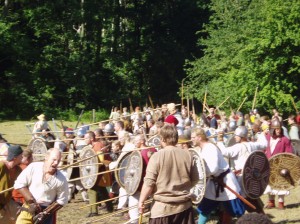Vikings oho! Posted by Bjørn A. Bojesen on Aug 2, 2011 in Culture
 This weekend, mysterious forces brought the Vikings back to life in Denmark. Between seven and eight hundred persons from all over Northern Europe had put on their Viking costumes, sheathed their swords, saddled their horses and set out for the wide fields by Moesgård Strand (beach) near Århus. Together with a friend I entered the throng of curious onlookers, who just couldn’t let go of their cameras in this brand-new Viking colony, consisting of medieval-style tents and booths where the modern-day vikinger (Vikings) were selling everything from exotic furs to drikkehorn (drinking horns, mostly made from the horns of cattle).
This weekend, mysterious forces brought the Vikings back to life in Denmark. Between seven and eight hundred persons from all over Northern Europe had put on their Viking costumes, sheathed their swords, saddled their horses and set out for the wide fields by Moesgård Strand (beach) near Århus. Together with a friend I entered the throng of curious onlookers, who just couldn’t let go of their cameras in this brand-new Viking colony, consisting of medieval-style tents and booths where the modern-day vikinger (Vikings) were selling everything from exotic furs to drikkehorn (drinking horns, mostly made from the horns of cattle).
The main draw of Moesgård Vikingetræf – one of the world’s largest Viking conventions – is, unquestionably, the battle. It is a weird but thrilling experience to watch 21st century adult men clashing together and whacking wildly at each other’s skjolde (shields) and brynjer (chain-mails) with blunt sværd (swords). The performance runs twice a day during the convention, and we were lucky enough to find a place to stand for the 3 o’ clock slag (battle).
Before the show started, though, riders of islandsheste (Icelandic horses) were given a chance to flash their skills. The Icelandic horse is popular in Denmark, because it has been bred in isolation in Iceland ever since the Viking Age and is therefore considered a ”pure” Viking horse. It is not much larger than a pony, and generally very patient and friendly. A Viking woman informed shoutingly that the Icelandic horse has five gaits or manners of walking. Most other horses only have three gaits (including gallop), so it was really fun watching those icelandic horses showing off their specialities, such as the tölt (one leg touching the ground, two legs touching, one leg …).
The horses gone, two fierce Vikings entered the field, exchanging words of spite. The tension rose and the spectators grabbed their beers and cameras as dozens of armored warriors came raging and yelling from either side of the slagmark (battle-field). Spears clashed against shields, swords smashed against axes. Some of the børn (children) in front of me looked anxiously at their forældre (parents).
Fortunately, it was all play, and the brave warriors were falling to the ground with a lot of audible pain but no blood. From a distance, though, you couldn’t always tell if a sword was stuck between the chest and the upper arm or really had entered the hjerte (heart)…
Finally, there were only two Vikings left, and after a bloodless slash a lithe warrior could raise his arms in victory. The spectators were cheering, and in a few seconds all the fallen krigere (fighters) were back on their legs, sweating and smiling in the sun.

Build vocabulary, practice pronunciation, and more with Transparent Language Online. Available anytime, anywhere, on any device.
About the Author: Bjørn A. Bojesen
I was born in Denmark, but spent large parts of my childhood and study years in Norway. I later returned to Denmark, where I finished my MA in Scandinavian Studies. Having relatives in Sweden as well, I feel very Scandinavian! I enjoy reading and travelling, and sharing stories with you! You’re always welcome to share your thoughts with me and the other readers.




Comments:
Alexander:
Love the smaller “viking” horses. Now a days its more a children horse. Its actually sad, given how great a horse it is.
Bjørn A. Bojesen:
@Alexander @Alexander – I agree. 🙂